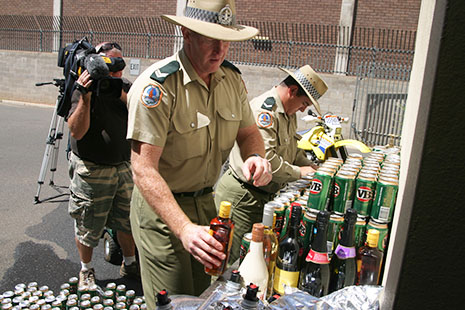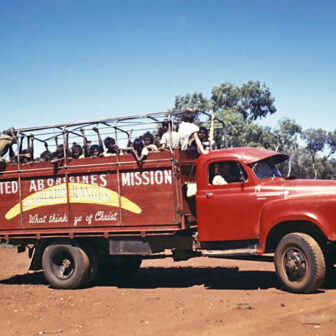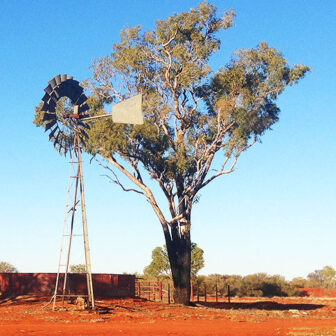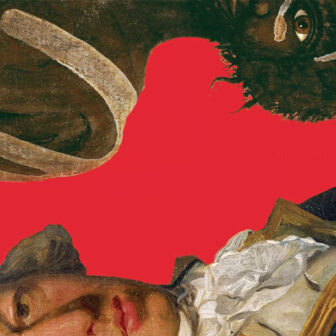“Have you had something to drink today?”
“No.”
“I said, have you had something to drink today?”
“No. I was working.”
“What did you say?”
“I was working this morning.”
IT’S NOT a doctor or a policeman snapping out these questions. It’s a security guard in one of the large liquor stories in Alice Springs. The man being quizzed is Aboriginal and he’s trying to buy a bottle of wine. The security guard stands just inches from him so he can smell his breath. Apparently convinced, he turns away.
A few moments later an Aboriginal woman enters the store. The security guard plants himself in front of her. This time the “breath test” seems to have a suspect result. The woman protests. The guard shoots both arms into the air, index fingers pointing skywards: “Out! Out! Out!” She heaves a sigh and leaves.
If these exchanges make buying a bottle of wine or a case of beer an uncomfortable experience for other customers in the store, they must be utterly humiliating for the Aboriginal customers. The practice is also absolutely discriminatory. None of the white customers is approached by the guard, unless for a friendly word exchanged at a normal physical distance.
I watched this scene during a quick visit to the store to buy wine one recent afternoon. The guard approached his job with a zeal all his own – it was a performance – but I have seen essentially the same interaction, resulting in the refusal of service to Aboriginal customers, on countless occasions. I have never seen a non-Aboriginal person refused takeaway service like this.
Buying and consuming alcohol remains a fraught negotiation for Aborigines in Alice Springs, governed by attitudes and regulations that have swung away from “rights” towards “harm reduction.” Their rights as consumers, as citizens, to be treated like others are being trampled as we in the mainstream attempt to save them from themselves and from inflicting harm on others.
How can this everyday discrimination be tolerated without complaint? The answer lies just outside the doors of the shopping centre, in the depressing spectacle of drunken Aboriginal people, men and women, from mid-afternoon on, carousing at best, or swearing, fighting, urinating, defecating and passed out in public places. It lies in the endless stream of statistics on appalling Aboriginal morbidity and mortality rates, in the litany of grog-fuelled violent crime that crosses my desk in the form of police media releases and Supreme Court sentencing remarks.
An example, not the worst: last year a man was sentenced to six years’ imprisonment, with a non-parole period of four years, for causing serious harm to a woman with whom he has a child. The victim suffered eleven stab wounds but survived. On the day of the attack the offender had been drinking alcohol and smoking cannabis from 5.30 am with the victim’s brothers. At some point he met up with the victim. She had money, which they used to buy more alcohol, and she joined in the drinking. The offender said he did not recall any of what happened.
Though rendered in the typically neutral language of sentencing remarks, the offender’s biographical details make for disturbing reading. He is an initiated Western Arrernte man; his first language is Arrernte, but he has a good command of English. At the time of the offence he was twenty-five years of age. He was primarily raised by his grandmother and uncles, who removed him from his parents because of his father’s violence. He grew up in a number of bush communities and had been to school, completing Year 9 and starting Year 10 at Alice Springs High School. He later obtained a welding certificate and was employed in building and fencing work. But at the time of the offence he had not worked for three years. He had started drinking alcohol when he was eleven or twelve years old and using cannabis soon after. He was described as suffering from chronic and severe alcoholism, and he used cannabis occasionally to increase the effects of alcohol.
While the offender was growing up he witnessed a great deal of domestic violence, including by his father towards his mother, and on a number of occasions he was beaten by his father and uncles. His father was killed in a fight when he was eight or nine years old and he was also greatly affected by the death of his brother, who died of a heart attack two days after the offender was initiated. The judge described the offender’s prospects of rehabilitation as “very problematic indeed” though not “without any hope at all.”
Some people growing up in circumstances like these manage to find a way out themselves, especially if they have the right kind of support. Here, for example, is the testimony of an Aboriginal man now in his thirties, resident of one of Alice’s town camps. Speaking in early 2009, before the majority of town camps signed sub-leases allowing the federal government to begin work on renovating and building new houses, he said he had begun drinking when he was twelve. Years earlier he had watched a dearly loved aunt begin to descend into alcoholism, first drinking flagons, then Fruity Lexia in five-litre casks. He says it ultimately killed her.
“Once you turn sixteen you become an alcoholic. That’s life in the camp,” he said, describing “violence and drinking every night,” kids not going to school, no one with a job, most of them drinkers, and men looking for young kids to break into houses and businesses to get grog for them. When he was seventeen he walked out of the camp. He turned eighteen in a refuge, was assisted by a young people’s accommodation support service to find a place to live and, with the help of counselling, got off the grog.
When I spoke to him again last year, along with a few of his friends, he was feeling a lot more optimistic about life in the camp, where he had returned to look after his invalid mother. New housing had given people hope, he said. But when I asked if lifestyles were changing, whether people were getting jobs and drinking less, he and his companions had to think for a moment. They said a couple of men had jobs. One of the men in the group, a young, fit-looking father of five children who don’t live with him, said his job was to look after his house and yard. As for drinking, one man argued that it was people’s right; the father of five said that residents should be free to drink in moderation in their own yards, like anyone else can. He was getting ready to do so, bottle of wine in hand.
Despite the fact that the Northern Territory Intervention still prohibited grog in the camps, the man I had interviewed before said that the drinking “comes in waves.” From the verandah we watched an older man, brandishing a thick stick, chasing a woman round and round the newly renovated house opposite. Both appeared to be under the influence of alcohol. She took refuge inside the house and he could be heard battering on the locked door. She was calling out repeatedly for people to phone the police, and he was calling out for them not to. “It’s our business!” he yelled. The group I was with didn’t want to get involved, worried that the man with the stick would create trouble for them.
THE BAN on drinking in camps has been enforced sporadically by police. It is clearly unenforceable in any consistent way, and it flies in the face of the federal and NT governments’ commitment to “normalising” the camps. It is also said to have pushed camp drinkers into public places in town, where they are unwanted, or to the fringes of town where they and those with them, including children, are even more vulnerable to harm. The ban is being wound back, with alcohol management plans being negotiated for clusters of camps.
These localised alcohol management plans are one of the NT government’s tools for dealing with the impact of alcohol. In Alice Springs, the plan in its present form includes restrictions on the hours of trade for takeaway liquor stores (which don’t open till 2 pm from Monday to Friday), a total ban on wine in casks greater than two litres, and restricted hours for the sale of wine in casks and fortified wines.
Almost all the focus of attention is on takeaway alcohol. Non-Aboriginal customers mostly look away while Aboriginal customers get their “special treatment” in the liquor stores, but many of them grumble when they get to the counter and have to produce some form of photo ID for scanning before they can make their purchase, or when they discover that they can’t buy their bottle of sherry or cask of wine till after 6 pm, and then only one cask at a time and a two-litre one at that. One local resident is so irritated by these restrictions that he uses “CaskWineDrinker” as his Twitter name. At a recent forum on the town’s future, due to start at 6 pm, he tweeted at 5.41 pm: “It’s now nineteen minutes until I can buy a cask of wine in UNFREE Alice Springs.”
He’s one of the many people in town who see buying and consuming alcohol as a rights issue, an argument that’s being given some credence when it comes from non-Aboriginal quarters. It’s likely he was among the 4000 local residents who signed a recent petition against a proposal that there should be no sale of full-strength alcohol without a meal before 2 pm. Golf-players, for instance, resented the fact that they wouldn’t be able to tipple at morning social games.
The proposed reform had been put forward by the local Alcohol Reference Panel, which provides feedback to government on the Alcohol Management Plan. It was ultimately rejected by the NT Licensing Commission as it would have been “resented” by the wider population and “would likely increase the social divide.”
The proposal came in the wake of controversy over Alice’s so-called “animal bars.” Not so many years ago the Animal Bar was the official name, painted on a sign out the front, of the Todd Tavern’s saloon bar. It’s been renamed the Riverside Bar and renovated to increase its capacity, but not much else has changed. Before noon on a recent weekday it was already packed, the single barman and a bouncer the only non-Aboriginal people in sight. Beyond that, nothing much distinguishes it from a basic country saloon bar – there’s music, TV, pool games. Two other bars like this operate at the Gapview Hotel and the Heavitree Gap Tavern, though the owners of the latter, Aurora Resorts and Hotels, say it is better than the others. It has, for instance, voluntarily pushed back opening till 11 am; the other two open at 10 am. Like the Riverside they have a predominantly Aboriginal clientele. At the Riverside a can of VB, the drink of choice, sets clients back $7. With prices like that, everyone would leave as soon as the takeaway opened at 2 pm even if the bars didn’t close, which they do. Many of the bars’ clients continue their drinking elsewhere, especially in the dry bed of the Todd River, in convenient proximity of all three bars.
The existence of the animal bars is common knowledge in Alice Springs. They are just part of the miserable landscape of Aboriginal drinking, ignored by all except those few who have committed themselves to fight against it. But when the ABC aired a national story linking the bars to the high rates of violence and early death among local Aborigines, there was outrage. The chief minister of the territory, Paul Henderson, declared that such venues had “no place in the Northern Territory” and “their time is coming.”
That was ten months ago. They are all still doing a fine trade. What has happened, however, is the development of a set of “amenity guidelines” for licensed premises, the rationale being that “decor, furnishings and operational management style contribute to the irresponsible consumption of alcohol and its associated behaviour.” Electronic ID systems, already in use for takeaway liquor sales, are also being trialled for on-premise service at the venues that host the animal bars. This will be reviewed after twelve months of operation and possibly extended. Both measures were further recommendations of the Alcohol Reference Panel.
Wait for more uproar from the “wider population” when and if they have to present ID for on-premises service. The argument always goes like this: “Why should the majority be punished for the problems of a minority?” This line is basically accepted by the NT government and its agencies, and so the latest reforms they have introduced target problem drinkers very specifically. From 1 July, photo scanners will be introduced territory-wide to check ID data against a Banned Drinkers Register. Banned drinkers will include those taken into protective custody three times in three months or people who commit alcohol-fuelled crime or violent offences. The ban period can be reduced by attending treatment or rehabilitation, but drinkers who breach bans will have longer bans imposed or be ordered to attend treatment and rehabilitation. In announcing an awareness campaign ahead of the introduction of the reform, the territory’s alcohol policy minister, Delia Lawrie, said, “For the majority of Territorians who are responsible drinkers, the scan is a small inconvenience to help police and social services turn problem drinkers off tap and get them into treatment.”
ALTHOUGH studies have shown that if Aboriginal drinkers are taken out of the equation, NT residents still drink much more per capita than other Australians (52 per cent more is the quoted figure), the problem is overwhelmingly seen and dealt with as an Aboriginal problem. This is particularly because of the way Aboriginal drinking is very visible to the general public (especially in the warmer months) and because of its association with violent crime, especially of the kind illustrated earlier – horrific violence visited on women, often the partners or relatives of their drunken attackers.
Scarcely a week goes by without the report of some awful assault, usually black on black, occasionally black on white (always the cause of high anxiety), rarely white on black or white on white. No one was really surprised to hear reports of the latest NT Department of Justice statistics, which show that in the twelve months from October 2009 to September 2010 there were 1688 assaults in Alice Springs, nor that in the six years to September 2010 there was an 87 per cent increase in this category. Darwin, by comparison, a city with three times the population, had seventy-nine fewer assaults, though its total also represented a significant increase, 67 per cent, over the six-year period.
The good news for Alice Springs is that murders and manslaughters appear to be in decline. The published figures, based on police reports, for each of the six years to September 2010 look like this: five, five, six, two, four, one. The comparable figures for Darwin are: one, one, three, four, three, two.
Although the numbers are too small to be statistically significant, this apparent decline has been attributed to reduced consumption of alcohol. In its early years of operation the current restrictions regime was credited with an 18 per cent reduction in the overall population’s consumption of pure alcohol. This improvement has apparently been eroded over the last eighteen months by the promotion of cleanskin bottled wine selling for as little as $2 a bottle.
Campaigners want to see these ultra-cheap products eliminated. Among them are a local doctor working with an Aboriginal health service, and a local legal aid lawyer, both in a position to see at close quarters the terrible price of excessive drinking. They and their supporters are pushing for the introduction of a floor price to make a standard drink cost a minimum of $1.20, the current price of the cheapest full-strength beer. This would quadruple the price of the cheapest wines and, they argue, would achieve a switch to beer, which is less harmful. (Before ultra-cheap wines undermined the current supply restrictions, there had been a 70 per cent shift to beer in Alice Springs and an 85 per cent shift away from cheap wines.) With a floor price, quantities consumed would also be limited by affordability.
This campaign gained a fair amount of publicity during Julia Gillard’s recent visit to Alice Springs. The prime minister was not particularly encouraging in her public statements here, deferring to the NT government on the issues. But the NT government has moved quickly to close the gate on any idea that it might take the initiative on a floor price, making it perfectly clear it would not be prepared to pay the electoral price that such a measure would exact. Announcing the decision in her media release of 15 June, Lawrie said, “Such a policy would penalise the majority for the sake of a few, with no real benefit to the community besides increasing profit for alcohol retailers. The Territory Government is leading the way in tackling alcohol-related crime and anti-social behaviour, with the toughest alcohol reforms in the country. Under our reforms, problem drinkers will be banned, but it is drinks as usual for the rest of us.”
That’s not necessarily the last word, of course. Although it seems likely that the Northern Territory’s latest reforms will be given some time to prove themselves, the federal government could, in the style of the Intervention, again treat the territory as a special case and impose a floor price. It would have to be convinced, though, that the measure would reduce harm at the worst end of the spectrum. However effective a floor price might be in reducing overall consumption, it would seem to presume a population of orderly citizens who pay attention to affordability, who feed their children before they spend their last dollar on drink, and who don’t consider whatever reckless means necessary to feed their addiction. That presumption is shaken by the current conditions in Alice Springs. Getting hold of alcohol has driven break-ins, both of commercial premises and homes, to new heights in the town. Bottleshops that can be approached by car have erected barricades to protect themselves from ram-raids.
Published figures for the most recent twelve-month period show house break-ins up by 80 per cent; over the preceding six years they’d risen by 75 per cent. Commercial premises break-ins were down slightly, by 8 per cent, but over the preceding six years they’d risen by 146 per cent. Again, the comparison with Darwin is instructive. Alice had 433 commercial premises break-ins in the twelve-month period; Darwin had 573.
For some years now I’ve felt that no amount of tinkering with the way alcohol products come onto the market can really make a fundamental difference in Alice Springs. Perhaps that’s because the “tinkering” is just that, always a pill just bitter enough for the general populace to swallow but not so bitter as to be effective. Meanwhile, the continual debate around managing alcohol can be a huge distraction from paying attention to the rest of what is required to ensure the opportunity of a purposeful, safe and independent life for all. How can we equip those who, like the young man mentioned earlier, walk away from a life of alcohol- and welfare-dependency, looking for something better?
When I ask her what will help, Aboriginal advocate Bess Price prioritises education. As the senior Warlpiri woman said at a recent talk in Sydney, broadcast on the ABC’s Background Briefing in May, “These young people need a real education like the one I got with my parents’ support. My people are linguistically talented, much more than the average whitefella. For some reason the schools haven’t taught our kids to speak English properly, let alone read or write. If they had taught them properly then they could speak for themselves and we wouldn’t have all these other self-appointed ones speaking for them.” People who could speak for themselves, who could manage alcohol for themselves within the general regulatory framework no different from “the rest of us,” who could tell obnoxious security guards where to go…
The situation with education in bush communities remains pretty dire, as Price suggests, but to end on a more hopeful note let me briefly describe the work of educators at Centralian Senior Secondary College, the only public senior secondary education provider in a radius of 500 kilometres of Alice Springs. They are steadily making inroads on Aboriginal student under-achievement, step by step, from year to year. Since 2006 Aboriginal enrolment at the college has gone from 17 per cent to 51 per cent. The educators’ aim is to have as many Aboriginal students completing Year 12 as their proportion in the total enrolment. And instead of seeing capable Aboriginal students languish in “community studies” (work and life skills programs), they have been designing courses to raise the bar and take them into academic achievement.
This year, twenty-four of the eighty-five students at the college likely to complete Year 12 are Aboriginal. They join cohorts of a similar size from the past few years, making over one hundred role models out there for other young people – including ultimately the students’ own children – where a few years ago there were a mere handful. Around six Aboriginal students each year, with a high of ten in 2009, have been achieving ATARs, the ranking that allows them admission to university courses.
Some of these students have great, supportive families, but some face very significant challenges, living at refuges or not knowing where they are sleeping from one night to the next, in some cases even sleeping rough in the stairwells of the college. They keep coming to school because, as one of their teachers says, “Where else can they go to feel safe and be with friends?” This provides a “last opportunity” to work with these young people before they head into the adult world, and the college is seizing it. •




